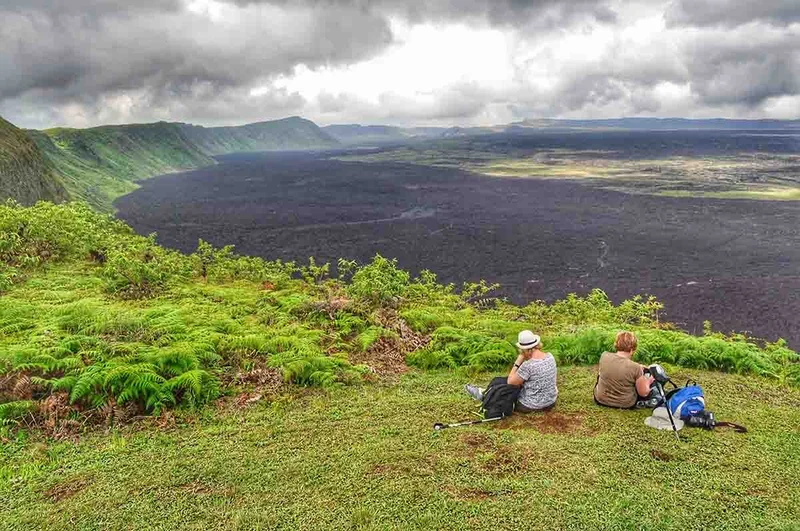

8 Day Galapagos Itinerary
Day 1: Santa Cruz Island: Highlands
Upon arrival at Baltra Island airport (from Quito or Galapagos, travelers pass through an airport inspection point to insure that no foreign plants or animals are introduced to the islands. After clearing the entrance to the national park, our guide will meet you at the lobby, collect your luggage, and escort you on the short (15 minutes) bus ride to the Itabaca Channel. After crossing the canal using a small ferry, we will board our bus for a 45 min / 1-hour drive towards the small city of Puerto Ayora.
From the pier of the town, motorized zodiacs (called ‘Pangas’) will transport you aboard the M/C Yacht Catamaran ANAHI. Once on board, our crew welcomes you with a refreshing drink and after being accommodated in your cabins you are invited for lunch and after a short rest.
Highlands
At about 2 p.m. you will be transported to the highlands of Santa Cruz Island, up to a private farm where you will enjoy your first visit to the Galapagos Islands. Our guide will take you for a nice walk among the beautiful trees of the forest including ferns and sedges, miconias, etc. Here you will be amazed with the giant tortoises that roam freely in the farm, their natural habitat. The Tortoises are very shy, and will typically withdraw into their shells as soon as they see you coming close. It is very important not to bother, touch or feed these beautiful animals. The area also contains several species of birds including the famous Darwin finches, the rare “Pájaro Brujo” (Wizard Bird) with it’s beautiful red coloration, and many more. At this place we also find a simple but nice structure where you can rest and buy drinks, beers or a try delicious local fruit juices and snacks. Later on you’ll head to one of the many lava tunnels existing in the area. Here you enjoy of a short hike into the tunnel, where one can admire the amazing results of powerful volcanic eruptions occurred some 5 million years ago that shaped the islands we know now. We’ll head back to Puerto Ayora and to the yacht after this visit point, and at 7 p.m. you will have the official welcome drink followed by dinner. After dinner The guide will explain about the next day’s activities as well as some general recommendations for travelers in the Galapagos islands.
Day 2: Isabela Island: Puerto Villamil & Sierra Negra Volcano
Puerto Villamil
Isabela Island is the largest and youngest islands in the Galapagos archipelago. From Puerto Ayora the navigation towards Isabela will start at about 1 a.m. arriving at about 6 a.m.to the port of Puerto Villamil. At 6:30 a.m. you will be awaked up by the guide and breakfast will be ready at 7:30 a.m.
Las Tintoreras
At the morning, we start our first visit to the islets known as Las Tintoreras. Access to this location is easy where visitors can land during high or low tide to this beautiful visitor site located south of Puerto Villamil. It has a small bay of completely calm turquoise waters, where you can appreciate sea lions, sea turtles, marine iguanas, rays and many more species of Oceanside fauna and flora. The bay is connected to a shallow crevice of crystal clear water which closes when the tide is low, and is a
favorite resting spot for sharks and fish life. Most of the trail in this visit point is “Ah Ah” Type Lava, except for a white sand beach and a black stone beach. The first beach we will encounter is popular with sea lions that are found sleeping peacefully, as well as marine iguanas that nest in the area. You can also see some Nolana galapageia plants, a rare endemic plant in the area not common in Ecuador, since this species is typical of continental coastal zones and belongs to a genus whose distribution is
restricted to Chile and Peru.
The second beach is entirely surrounded by button mangrove (Conocarpus erecta) and white mangrove (Laguncularia racemosa). Throughout the trail you can see many marine iguanas in the rocks or under the mangroves.
Las Tintoreras is one of the few places where the iguanas breed successfully because of the absence of non-native animals that could kill the new born reptiles. Various parts of Las Tintoreras are ideal for nesting marine iguanas. During nesting season be very careful when exploring the area. Reef sharks (here known as Tintoreras) have nocturnal feeding habits and certain individuals remain inside the crevice and marine ponds during the day to rest. For this reason, you are not allowed to swim in this place. We’ll head back to the yacht for lunch and relaxing.
Sierra Negra Volcano
After the visit to Tintoreras, you disembark to Puerto Villamil to head up to the highlands of the Sierra Negra Volcano that is a large shield-type volcano located at the South eastern end of Isabela Island and it rises to an altitude of 1124m. It sits between with the volcanoes Cerro Azul to the west and Alcedo to the north. It is also one of the most active of the Galapagos volcanoes with the most recent historic eruption in October 2005.
Our guided tour of the volcano starts at Puerto Villamil with a car drive of about 30 minutes to where we start our 1 hour walk towards the rim of the giant caldera along its East side. The view is really amazing and impressive since the caldera, with dimensions of 7.2 x 9.3 kms, is considered the 2nd biggest crater in the world (after the Ngorongoro crater in Tanzania). From the several viewpoints located along the rim of the crater we can observe down inside of the crater the recent lava flow of the
2005 volcanic eruption. After another 2 hours hike from the rim of the Sierra Negra crater, the area known as Volcan Chico is located, an interesting sight where it is possible to observe some fumes, and explore this Martian-like landscape. From here we can also observe the faraway volcanoes of Isabela Island. This last visit is recommended for those tourists with good physical conditions and depends on the group.
Wetlands
After we take lunch, we will visit the area known as The Wetlands where you can see a variety of endemic wetland birds. Then of this visit we will have a free time in the small town of Puerto Villamil. We aboard the yacht for a well-deserved dinner and rest.
Day 3: Isabela Island: Punta Moreno & Elizabeth Bay
Punta Moreno
Punta Moreno is located on the north coast of Isabela Island between the volcanos Sierra Negra and Cerro Azul. The distance of the trail is about 2100 meters and runs along a lava flow of “Pahohoe” type lava (solidified lava in the form of corrugated cardboard or an accordion) into a complex of coastal lagoons. The vegetation found in the area is small and concentrated mainly in the mangrove area and around the lakes. It should be noted that the three kinds of cacti are found here amid black lava flows where there are several species of interesting birds. Here we also find a panoramic view of the three most active volcanoes of the Galapagos: are Sierra Negra, Cerro Azul both of Isabela Island and La Cumbre of Fernandina Island. Unfortunately, until the 1970’s a population of wild dogs that existed on this site fed on marine iguanas, sea lions and other marine species and drank the abundant brackish water present here, but are now eradicated. After this visit we return to the boat for lunch and a short rest before heading into our afternoon activity.
Special Indications:
Do not frighten the Flamingos. They are sensitive to noise and get scared easily. Stay within the group. The road to the large lagoon is long and dangerous, where you have to cross 700m of broken lava, making it somewhat difficult to walk. Wear comfortable and appropriate shoes for this type of hike. Due to high temperatures and strong sunshine, especially during the hot season (December to May), it is better to take the activity in the early hours of the day or late afternoon due to type of
terrain.
Elizabeth Bay
Since there is no landing point at Elizabeth Bay, this excursion is carried out in a zodiac., this excursion starts into the cove that is surrounded by red mangroves where you can admire their red roots and green leafs. It is here that you are able to observe sea turtles, flightless cormorants, spotted eagle rays, golden rays, brown pelicans, and sea lions. Frequently visitors have been able to see Galapagos hawks soaring overhead while schools of Pompano and Dorado fish swim below. This site is really amazing
due to the high quantity of land and marine wildlife as well as the unique and beautiful landscapes.
We’ll return to the yacht for dinner and rest.
Day 4: Isabela Island: Urbina Bay & Tagus Cove
Urbina Bay
This walking visitor site is located at the east base of the Alcedo volcano. The trail has an approximate distance of 3200m, and starts on the beach where a wet landing is made, and runs through sand, rock, lava, coral and vegetable formations in a coastal area. This area is considered amongst the best showcases of the geological formations of the islands as many aspects of the creation of the archipelago can be seen. The waters of the bay are a good place to see turtles and rays, as well as head into a short trail leading to a coral reef above the surface of the water, evidence of uplift from the sea which occurred in 1954.
From here it is easy to reach the Alcedo and Darwin volcanoes. Here you can see large, colored land iguanas, as well as giant Galapagos turtles, flightless cormorants, blue-footed boobies, Galapagos penguins, pelicans, and marine iguanas.
Tagus Cove
We will return to the yacht to enjoy a delicious lunch, followed by a short navigation to Tagus Cove. A tour along the cliffs in a zodiac will give the visitors a good chance to see the Galapagos penguin, the flightless cormorant and other sea birds. From the landing dock a 30-minute hike along the trail up to the top of the cliff takes you to a viewpoint of Darwin Lake, an uplifted ultra-saline lake. You can also see several volcanoes from this location. The route of the trail is about 1800 meters, and was considered a favorite spot for pirates and whalers, a tradition continued with the names of boats and ports. At the start of the walk, we find a small cave where we find inscriptions dating to the 1800s. The trail is mostly gravel, and leads into the interior of the island along Darwin Lake. During the walk, you can see various land birds and identify the characteristic vegetation of the arid zone.
Finally, we observe the lava fields of Darwin Volcano. Darwin Lake rests upon a “tuff” type cone, contains saltwater and its depth is approximately 9m. It has no fish and few forms of life due to its high salinity. Explosive volcanic eruptions must have occurred at the site, as the substrate has a large amount of volcanic rocks of different sizes, among the most common are little balls of nearly perfect spherical shape known as the “lapilli” or petrified rain.
Day 5: Fernandina Island: Espinoza Point & Islabela Island: Vicente Roca Point
Fernandina Island: Espinoza Point
Fernandina is the third largest island in the archipelago and has a single visitor site. Espinoza Point is located at the northeastern tip of the island, and is a narrow ledge of lava and sand that extends from the base of the volcano to the sea. The last recorded eruption of the island, occurred in May 2005 and lasted three days. The greatest recorded explosive eruption was in 1968, where two thirds of the caldera floor collapsed inwards to a depth of 300m.
In 1989 the last two land iguanas that inhabited this area died of starvation, and it is believed that these two animals came down from the flanks of the volcano, where they are numerous. Espinoza Point is a place famous for its large colonies of marine iguanas and as the habitat of unique species like the flightless cormorant, Galapagos penguin, Galapagos hawk, Galapagos snake, among others, as well as an ideal place to observe the lava cactus (Brachycerus nesioticus), which grows on young lava and can survive with little water. After this visit, is possible to snorkel in the area, where you can swim with marine iguanas, and large colonies of sea turtles, and if we are lucky, the beautiful seahorses.
Islabela Island: Vicente Roca Point
Locals believe that Isabela Island has the shape of a sea horse, where is Vicente Roca Point is located at the mouth of the animal. Here the remains of an ancient volcano form two turquoise coves with a well-protected bay from the ocean swells.
From here, we take panga rides along the cliff to observe the remains of the volcano or explore a partially sunken cave at the water’s edge. Masked and blue-footed boobies sit perched along the point and the sheer cliffs, while flightless cormorants inhabit the shoreline. You can also see the fur sea lions, the incredible mammals very similar to the curious Galapagos sea lions.
The upwelling of cold-water currents in this part of the Galapagos, give rise to an abundance of marine life which, in combination with the protection of the coves, make Vicente Roca Point, one of the archipelago’s most coveted diving spots. The entire area of Punta Vicente Roca lies on the flank of the 790 m (2,592 ft) high Volcano Ecuador, the Island’s sixth largest volcano. At the end of our activity in the area, we will begin navigation, which will cross the equatorial line. At this point, we will have a special cocktail to celebrate the crossing to the northern hemisphere.
Day 6: Santiago Island: Egas Port & Rabida Island
Santiago Island: Egas Port
The visitor site Egas Port is a black sand beach located on the west side of James Bay, northwest of Santiago Island. South of the beach is Sugarloaf Volcano, which has deposits of volcanic tuff, the same that has favored the formation of the black sand beaches across the archipelago. El Crater is just north of this site; and has a saltwater lagoon, which during the summer dry season becomes a salt mine which was attempted first between 1928 and 1930 to no major success, followed by a new attempt in 1964 which lasted for a longer period. These entrepreneurial attempts caused environmental damage due to the usage of native and endemic wood firewood and the introduction of invasive plants and animals.
This site is called Puerto Egas, after Mr. Hector Egas who attempted to exploit salt here and failed due to the price of salt in other areas of the country. The walk along the rugged shoreline, especially at low tide, will allow us to observe many marine species as Iguanas bask on the rocks and sea lions laying in the tide pools. At the end of the trail there is a series of grottoes or sea caves where fur seals and night herons are regularly found resting on the shady ledges.
You have the opportunity to snorkel from the beach of Puerto Egas, to enjoy the seascape relatively different from what we have seen in previous days.
Rabida Island
In the afternoon we will visit Rabida Island, unique due to the red color of the rocks and sand. The volcanic material in this island is very porous and external factors such as rain, salt water, and sea breeze have acted as an oxidizing agent. Upon arrival we will enjoy a snorkeling activity, to learn about marine life in this area with interesting species.
Later we will visit the terrestrial visit site that is located on the east coast of Rabida Island, consisting of a red sand beach, a coastal lagoon behind the beach, and a loop trail. The approximate distance of the trail is 1.1 kilometers. A short walk along a trail will lead you to the lagoon to observe the beautiful land birds such as finches, doves, yellow warblers, and mocking birds. This lagoon is also a colony of Flamingos. The red sand beach, along with the animals, lagoons and vegetation make this a great visit spot!
Day 7: Chinese Hat Islet & Bartolome Island
Chinese Hat Islet
After a nightly short navigation, you will dawn in the beautiful Chinese Hat Chanel. This small islet is located near the south-east coast of Santiago, and has been nicknamed according to its unusual shape akin to a Chinese Hat when seen from afar. Through observation and study of the island, it has been concluded that the lava flows near to its shoreline were formed under the sea and have been raised upward, which is why coral heads are found on the lava.This visit provides an excellent opportunity for the interpretation of geological features such as lava tubes and lava flows. The landscape is covered by sea lion colonies, marine iguanas, and Galapagos penguins.
The trail is 700 m (round trip) and the minimum time it takes this trek is half an hour at a moderate pace. You will swim on this wonderful bay with sharks, stingrays, fishes, and occasionally penguins, before to return to the yacht to enjoy a delicious barbecue on the Yacht ́s Upper Deck. Also, we could explore the area in Kayaks visiting the interesting geological formations from the surface.
Bartolome Island
Bartolome is one of the most famous points in the Galapagos, located across from Sullivan Bay near to Santiago Island. Arriving to this special site, we have the opportunity to swim around a pinnacle, and between rocks that salen to the surface forming amazing sea life labyrinths. first of the two main visitor sites provide the possibility to climb to the summit of the island, later, we visit the summit of the island, from where visitors can observe a variety of volcanic formations including lava bombs, spatter and cinder cones, lava flows, and lava tubes. The moon like landscape provides one of the most scenic panoramas in the archipelago.
At the second site, visitors have the chance to relax on a beautiful beach, which offers great snorkeling opportunities. Multi –colored fish and occasionally penguins and sea turtles have been seen at the base of the tall pinnacle rock, which dominates Bartolome’s landscape.
Day 8: North Seymour Island & Transfer out
North Seymour is located north of Baltra, our last visit in this itinerary aboard of Anahi Yacht, where the total distance of the trail is 3.5 km (2 miles). In 1932 and 1933, about 72 land iguanas from Baltra were introduced to North Seymour by Captain
Alan Hancock and his crew with the intention that these animals could survive in better conditions than in Baltra, already populated by goats. The iguanas that the crew of Valero III (Hancock’s ship) taken from Baltra were undernourished and after the introduction into North Seymour in 1934 it was discovered that the iguanas had colonized the island without problems.
Later, during the Second World War when the United States occupied Baltra to install a military base, the land iguanas disappeared slowly as their habitat was altered for the construction of runways and barracks for soldiers and the invasive presence of goats, dogs and cats. By the end of 2008, 600 iguanas have been accounted for on North Seymour, of which 400 have been repatriated and 200 were born in the wild. Nowadays, with the eradication of introduced species in Baltra, we can find the population of the largest land iguanas in the archipelago, and with a very good area for its reproduction. The main vegetation bushy and low, hosting the largest nesting colony of Great Frigate birds in Galapagos.
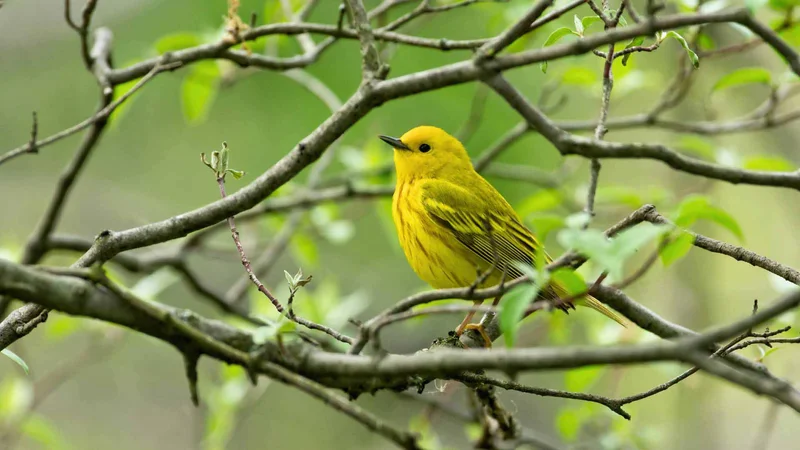


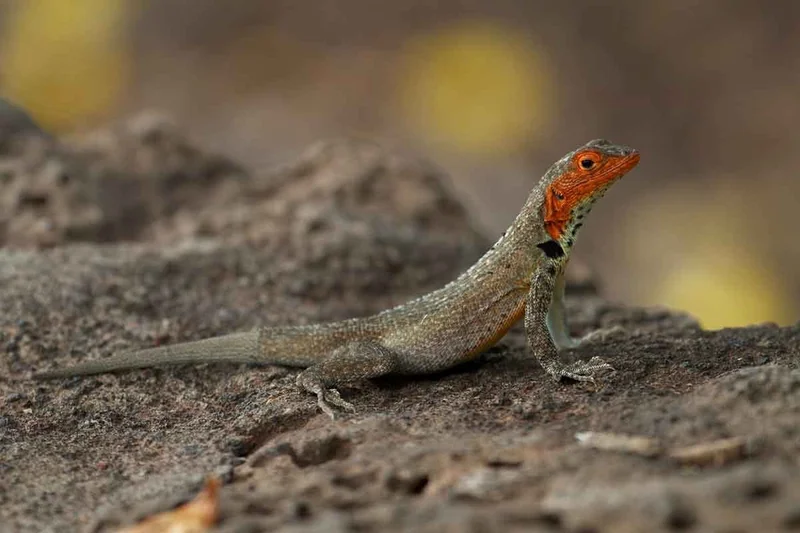

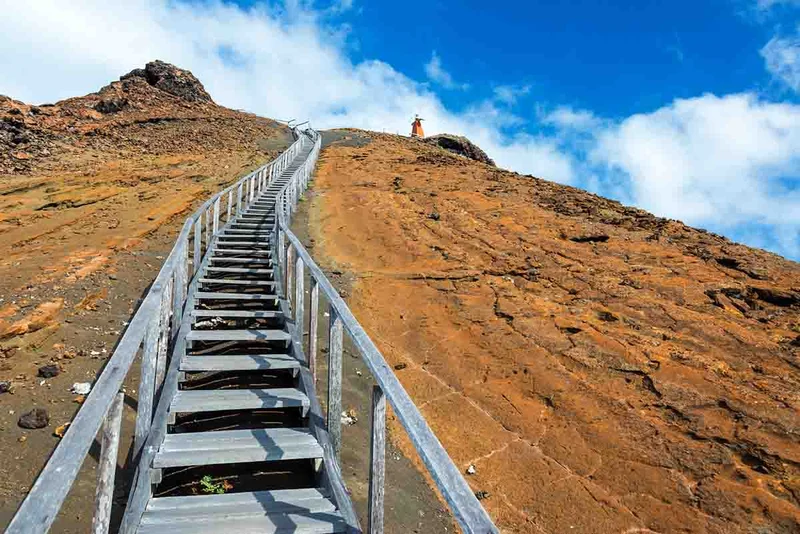


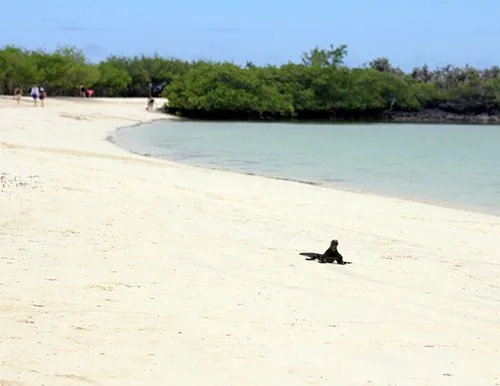
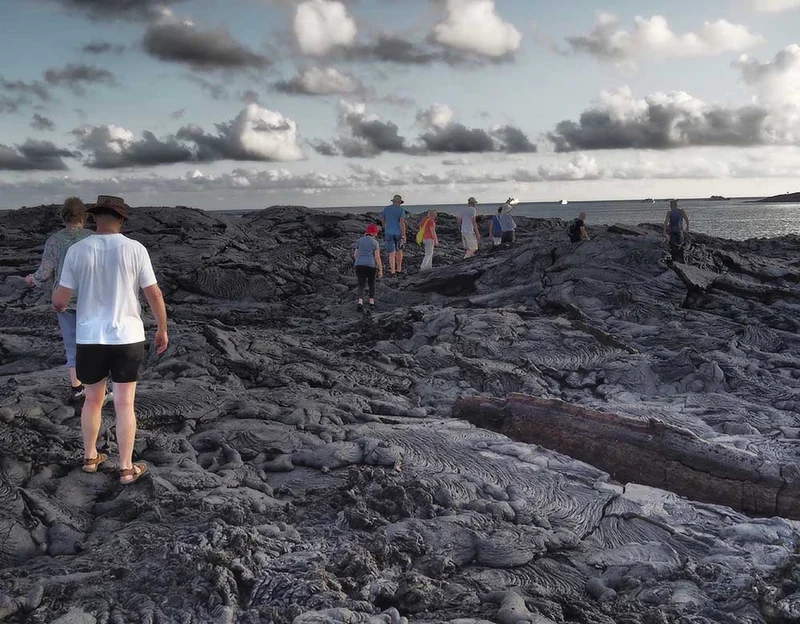

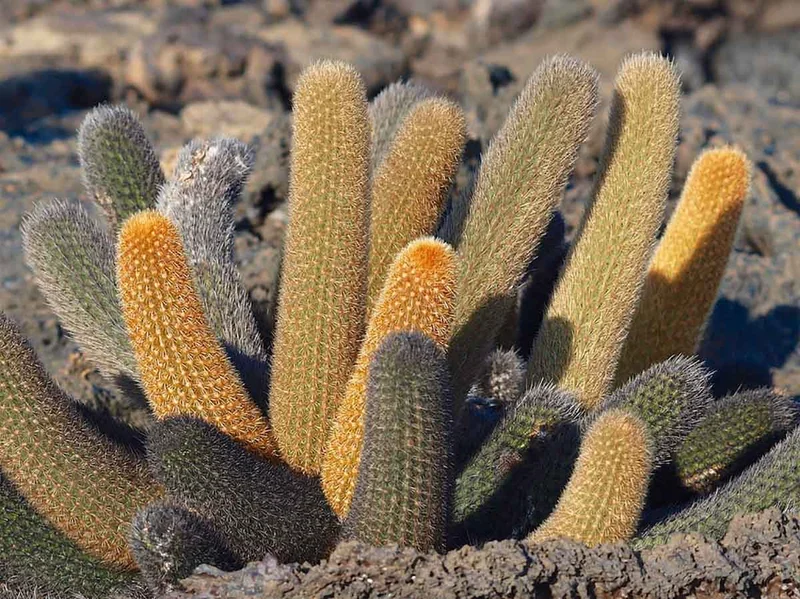



8 Day Galapagos Itinerary Includes
- All meals indicated in the itinerary
- Coffee and tea station as well as purified water dispenser
- Excursions mentioned in the program
- Transfers to and from the Anahi Yacht Catamaran
- Bilingual naturalist guide (Spanish / English) certified by the Galapagos National Park
- Mask and fins for snorkeling
8 Day Galapagos Itinerary Does not Include
- Meals not indicated in the itinerary
- Additional alcoholic and non-alcoholic drinks
- International and domestic flights
- Entrance fee to Galápagos National Park
- Traffic Control Card
- Personal travel insurance
- Tips for the guide and crew
- Surcharges for increased fuel costs
- Neoprene suit for snorkeling
8 Day Galapagos Itinerary Highlights
- Explore the worlds second largest volcanic crater at the summit of Sierra Negra volcano on Isabela Island
- Swim alongside marine iguanas, flightless cormorants and tropical penguins
- Walk on top of an island that has the form of a chinese hat and explore its constrasting red vesuvium flowers and lava fields where marine iguanas graze
- Walk on pristine beaches and as playful sea lions bark at each other as if they were talking about you
- Land on the active Fernandina island, the youngest in the archipelago and observe lava lizards, marine iguanas and possibly racer snakes
Itinerary Map

Reviews
Animals you might see on this itinerary:
More information about the Galapagos Islands you visit in this 8 day itinerary:
Galapagos catamaran west islands vacation itinerary 8 days M/C Anahi
Why travel with us?
Similar Itineraries


